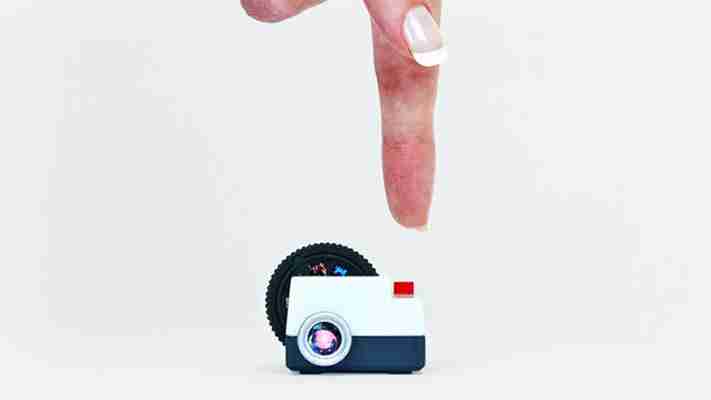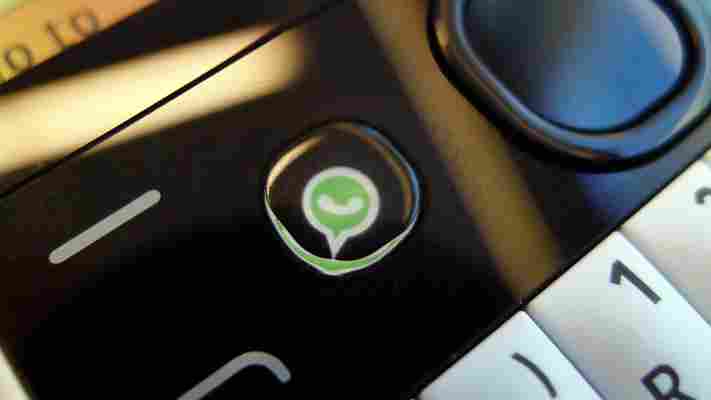At its Worldwide Developer Conference (WWDC) today, Apple announced a very important update to Siri: you can start talking to her without having to touch your iPhone. This is triggered by the hands-free phrase “Hey, Siri.”

As part of the update, Apple has built in Shazam song recognition as well as streaming voice recognition. Siri also now supports purchasing iTunes content and has gained 22 new dictation languages.
In other words, this is Apple’s response to the always-on “Ok, Google” feature in Android. The company is well-aware of Google Now and Microsoft’s Cortana, and while today’s news is notable, the fact Apple spent so little time on Siri during WWDC is curious. We assume we’ll be learning a lot more as iOS 8 nears release.
Image Credit: Oli Scarff/Getty Images
Projecteo hits Kickstarter to show off your favorite Instagram images using a tiny analogue projector
Projecteo , a miniature projector for showing off all of your favorite Instagram photos, has been launched on Kickstarter today .

The product itself comes in two parts; the projector, which looks about the size of a paper clip, and a slide wheel for alternating between nine images.
What’s novel about Projecto is that everything about it is analogue. So rather than simply projecting a digital image, users would log into the Projecteo website, authorise their Instagram account and then select nine of their favourite images. Projecteo then develops these onto a piece of 35mm Kodak film stock, just like in the old days, before then posting it back to you as a slide wheel.
All you have to do then is throw the slide wheel in and start projecting it onto a blank wall. Voila!
Projecteo has been dreamed up by Ben Redford, who works at an agency and product development company called Mint Digital. The idea needs $18,000 to begin mass manufacture, although a prototype has already been created with the help of a product development consultancy firm in Scotland called Meso.
We’ve already seen Mint Digital bring some ingenious ideas to life, such as Foldable.Me , which lets you create a 3D cardboard figure of yourself, as well as Stickygram , which turns your favourite Instagram images into magnets. So it’s safe to say this project is in pretty safe hands.
Projecteo’s inventor, Ben Redford, said:
If Projecteo is funded successfully, Redford believes they’ll be able to start making the projector properly as early as mid-Decemeber. Then, if the units meet the necessary standards and EU/FCC certifications, backers should be receiving their Projecteo around February. Which isn’t bad at all, all things considered.
If you decide to pledge $20 or more to the cause, you’ll be one of the first backers to receive a Projecteo. However, throw in a extra five bucks and you’ll have your first wheel developed straight away. For forty of your hard-earned dollars though, you can opt-in for a limited edition Projecteo coloured to represent the classic Rollei P35 slide projector . Nice.
If you’re really feeling generous though, – and I mean really generous – $350 will mean that the Projecteo designers sit down with you to create a projector that is completely unique. Colour combinations, a personal message, logo or name, everything is available for you to mess around with. $500, the top pledge bracket, will make it gold plated. That’s right. Plated in real gold.
If you’re a fan of analogue photography, this is a fantastic opportunity to have some of your favourite Instagram prints preserved in film form. However, part of Instagram’s success has undoubtely been its zero entry fee, as well as the ability to shoot and ‘process’ an unlimited number of shots for the world to see.
Projecteo is asking that you accept production costs and wait times again for each slide wheel, which will no doubt feel like an outdated concept to some. Others will argue that this is all part of the fun though, and how photography was always meant to be. We’ll let you be the judge.
Image Credit: Projecteo
Nokia unveils the Asha 210, a featurephone with a QWERTY keyboard and dedicated WhatsApp button
Nokia has unveiled the Asha 210 today, a new featurephone with a full QWERTY keyboard running the Series 40 mobile operating system.

As with the Asha 205 announced last November , the device has a dedicated button for accessing popular social networks. Facebook will be offered in Europe and Latin America, but for the first time ever, WhatsApp will be fitted on devices sold in the Middle East, Asia-Pacific and Africa.
WhatsApp has been available on Asha devices for sometime, but the partnership between the two companies is telling of just how popular the cross-platform instant messaging service is in certain regions.
If that wasn’t enough, WhatsApp is also offering its service to Asha 210 owners for free over the lifespan of the device. The app has never been particularly expensive to subscribe to, but it’s a nice touch that should encourage Asha 210 owners to stick with the service.
The Asha 210 will be sold as both a single and dual-SIM version for $72, excluding taxes and other subsidies. It only supports WiFi and 2G mobile networks (so no 3G or 4G connectivity), but the battery boasts up to 46 days of standby time for the single SIM, as well as 24 days for the dual SIM version.
The Asha 210 is also equipped with Nokia’s Easy Swap technology, enabling users to switch between multiple SIM cards depending on their coverage or airtime plan. An accessible door on the side of the device means that owners can change the secondary SIM without restarting the device; the primary SIM card is still kept in the back behind the battery.
It’s an affordable handset, but one that comes with its fair share of trade-offs and shortcomings. The Asha 210 is equipped with an unspecified, sub-1GHz processor, as well as just 64 MB of flash memory – although this can be increased by up to 32GB with a microSD card.
The modest 2-megapixel rear-facing camera comes with 4x digital zoom, but there’s no front-facing camera to speak of. Nokia has tried to sidestep this problem with its self-portrait mode, which helps users to take a picture of themselves using numerous voice prompts.
It’s functional, but the commands are a little stilted and the entire experience is likely to be more than a little embarrassing if you’re out in a public place.
The device will be available in yellow, black, white, cyan and magenta during the second quarter of 2013, although not all color schemes will be sold in every region. From a design standpoint, the Asha 2010 is very pleasing on the eye, with soft curves, a matte finish and (almost) unibody feel.
The Asha devices are designed to be affordable, but Nokia has managed to retain the build quality and hardware sensibilities that makes them such a popular choice in emerging markets. One example is the dedicated camera key on the right-hand side, which launches the relevant app even when the device is locked. It’s a small improvement, but one that will likely be welcomed by frequent snappers.
Throw in some of Nokia’s other exclusive software features, such as Slam sharing and the Nokia Xpress Browser , and its clear why the Asha line is shipping so many units. WhatsApp is also an incredibly smart choice; expect similar partnerships from Nokia down the line.
